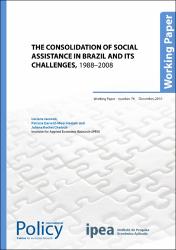Please use this identifier to cite or link to this item:
https://repositorio.ipea.gov.br/handle/11058/15784Full metadata record
| DC Field | Value | Language |
|---|---|---|
| dc.contributor.author | Jaccoud, Luciana | |
| dc.contributor.author | Hadjab, Patricia Dario El-Moor | |
| dc.contributor.author | Chaibub, Juliana Rochet | |
| dc.date.accessioned | 2024-10-04T00:07:47Z | - |
| dc.date.available | 2024-10-04T00:07:47Z | - |
| dc.date.issued | 2010 | |
| dc.identifier.uri | https://repositorio.ipea.gov.br/handle/11058/15784 | - |
| dc.description.abstract | The federal constitution enacted on 5 October 1988 was a landmark for Brazilian citizens in that it reorganised the bases of the country’s protection system. The new charter recognised social security as a guiding principle of social protection, as expressed in social insurance, social assistance, health and unemployment insurance policies. The constitution recognises a set of needs and provisions, previously restricted to the private sphere, as an object of public intervention and as social rights. Social protection for the elderly, the disabled, rural workers and people without access to social insurance began to be understood as the responsibility of the state, and as a civil right. Until then, the only options available to many socially vulnerable people were “family solidarity” strategies and, if they were absent or insufficient, philanthropic or charitable initiatives. This was the case for all those individuals not covered by social insurance, who were unable to continue working because of disability, illness or old age. That was why guaranteed access to social assistance was ensured to all those who needed it. The new approach taken to social assistance is part of a broader movement to review the principles on which the Brazilian social protection system was organised. The constitution consolidated benefits and expanded the coverage of the pension system by introducing a differentiated and partially contributory regime for rural workers in a “family economy”. It also established a universal right to healthcare by creating the Unified Health System (Sistema Único de Saúde, SUS), which was both public and free. Social assistance became a public responsibility under the social security system, and was integrated with policies on health and contributory social insurance. The 1988 constitution thus broadened the concept of social rights. Despite adverse circumstances arising from the economic difficulties of the 1990s and the opposition of political elites to the expansion of social protection, there was a gradual trend towards the consolidation of such rights. The focus on social vulnerabilities that were subject to guarantees of legal protection was broadened, thereby expanding public responsibility to address various problems that thereto were thought to be confined to the private sphere. In this process, state intervention began to refer to a broader aspect of social life, and its goals were to equalise access to opportunities, reduce inequalities, and tackle poverty and social risks. Its had important impacts on policy design and on the definition of beneficiaries and benefits. (...) | en |
| dc.language.iso | en | |
| dc.title | The Consolidation of Social Assistance in Brazil and Its Challenges, 1988–2008 | en |
| dc.type | Working Paper | |
| dc.rights.holder | International Policy Centre for Inclusive Growth | |
| dc.rights.holder | United Nations Development Programme | |
| dc.location.country | Brasil | |
| dc.description.physical | 36 p. : il. | |
| dc.rights.type | Licença total exclusiva | |
| dc.rights.license | O texto e dados desta publicação podem ser reproduzidos desde que as fontes sejam citadas. Reproduções com fins comerciais são proibidas. | |
| dc.subject.keyword | Social Assistance | |
| dc.subject.keyword | Brasil | |
| dc.subject.keyword | 1988–2008 | |
| ipea.access.type | Acesso Aberto | |
| ipea.researchfields | N/A | |
| ipea.classification | Cooperação Internacional. Relações Internacionais | |
| ipea.classification | Saúde | |
| ipea.classification | Administração Pública. Governo. Estado | |
| Appears in Collections: | Publicações do IPC-IG | |
Files in This Item:
| File | Description | Size | Format | |
|---|---|---|---|---|
| en_IPCWorkingPaper76.pdf | 352.52 kB | Adobe PDF |  View/Open |
Items in DSpace are protected by copyright, with all rights reserved, unless otherwise indicated.

